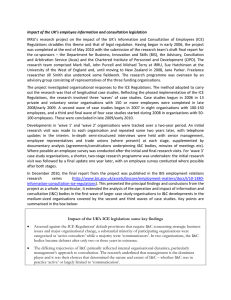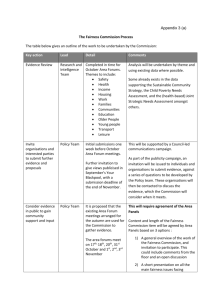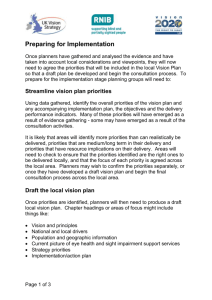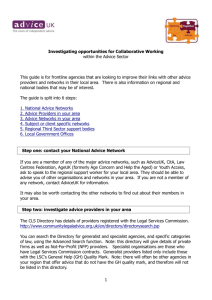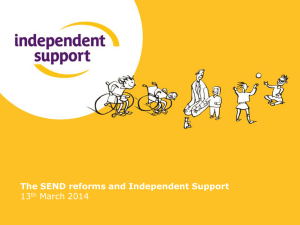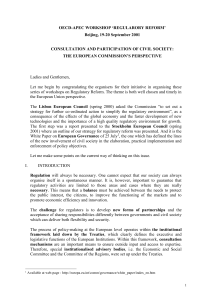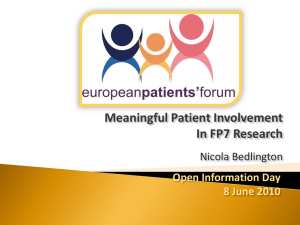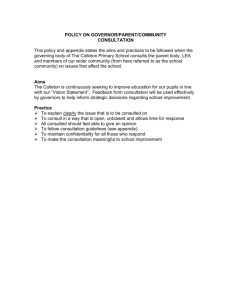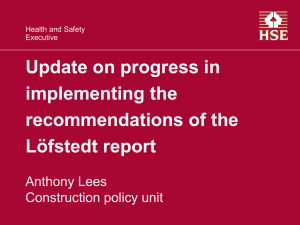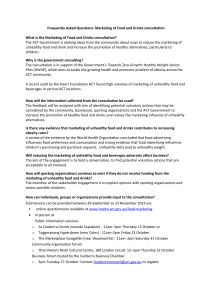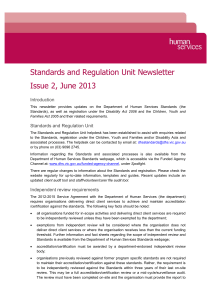Monitoring engagement using the National Principles for Public
advertisement
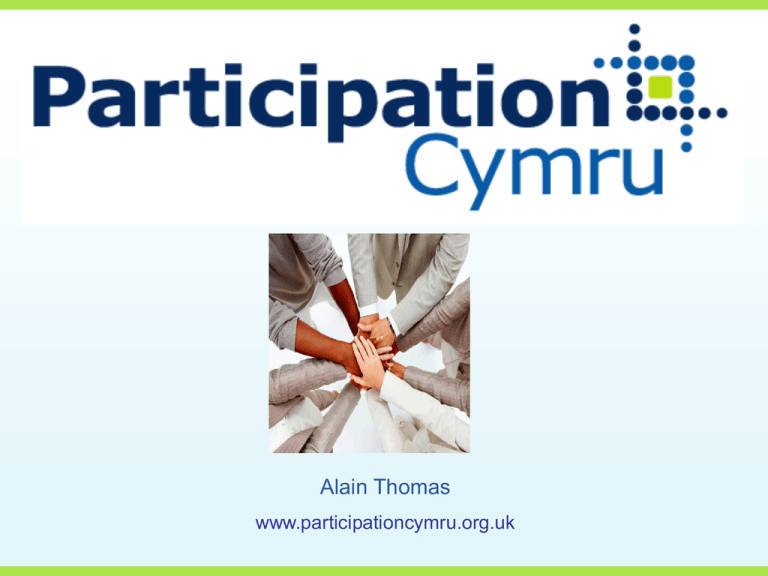
Alain Thomas www.participationcymru.org.uk Overview workshop • Background to the Principles • Definitions • The National Principles for Public Engagement • What is Engagement? • Implementation of Principles • What does 100% success look like? • Live case study • Principles into Practice • Next Steps Background to the Principles Aim To encourage good quality, consistent engagement activity with service users and the general public by those who provide services Background to the Principles • They are a set of national principles aimed at statutory and third sector Public Service providers • Principles have been finalised following a lengthy process of informal engagement and more formal consultation • They are overarching principles and not a ‘how to guide’ on public engagement Definitions • Engagement – An active and participative process by which people can influence and shape policy and services that includes a wide range of different methods and techniques • Consultation – A formal process by which policy makers and service providers ask for the views of interested groups and individuals • Participation – People being actively involved with policy makers and service planners from an early stage of policy and service planning and review National Principles for Public Engagement 1. Engagement is effectively designed to make a difference Engagement gives a real chance to influence policy, service design and delivery from an early stage. National Principles for Public Engagement 2. Encourage and enable everyone affected to be involved, if they so choose The people affected by an issue or change are included in opportunities to engage as an individual or as part of a group or community, with their views both respected and valued National Principles for Public Engagement 3. Engagement is planned and delivered in a timely and appropriate way The engagement process is clear, communicated to everyone in a way that’s easy to understand within a reasonable timescale, and the most suitable method/s for those involved is used. National Principles for Public Engagement 4. Work with relevant partner organisations Organisations should communicate with each other and work together wherever possible to ensure that people’s time is used effectively and efficiently. National Principles for Public Engagement 5. The information provided will be jargon free, appropriate and understandable People are well placed to take part in the engagement process because they have easy access to relevant information that is tailored to meet their needs. National Principles for Public Engagement 6. Make it easier for people to take part People can engage easily because any barriers for different groups of people are identified and addressed. National Principles for Public Engagement 7. Enable people to take part effectively Engagement processes should try to develop the skills, knowledge and confidence of all participants National Principles for Public Engagement 8. Engagement is given the right resources and support to be effective Appropriate training, guidance and support are provided to enable all participants to effectively engage, including both community participants and staff. National Principles for Public Engagement 9. People are told the impact of their contribution Timely feedback is given to all participants about the views they expressed and the decisions or actions taken as a result; methods and form of feedback should take account of participants’ preferences. National Principles for Public Engagement 10. Learn and share lessons to improve the process of engagement People’s experience of the process of engagement should be monitored and evaluated to measure its success in engaging people and the effectiveness of their participation; lessons should be shared and applied in future engagements. Levels of Engagement Engagement Model Inform Listen/consult We will tell you what we’re doing, advise you, answer questions, signpost information. We will ask questions, listen to your concerns and suggestions, use your feedback to develop policy, services and legislation. Channels: website, media, campaigns, publications, advertising, events/conferences, telephone, email, face-to-face Channels: blogs, online forums, surveys, focus groups, consultation, public and 1:1 meetings, front-line feedback, stakeholder and citizen panels Audience: citizens, stakeholders Audience: citizens, stakeholders, special interest/representative groups Involve/Partner Empower/Delegate We will work together to design and deliver policies and services, share decision making, maintain relationships. We will give you responsibility for making decisions, managing resources and delivering policies and services. Channels: workshops, advisory panels/committees, liaison groups, 1:1 relationships, citizens’ juries/forums, community toolkits, online forums/web-chats, networks, 'doing the day job’ Channels: participatory budgeting, grant giving, contracting, ballots Audience: citizens, local service boards, spatial plan groups, partnership councils, communities Audience: local authorities, health boards, businesses, farmers, ASGBs, nongovernmental organisations, communities Implementation of the Principles Self Evaluation Tool - 5 stages 1.0. Allocate responsibility and build capacity for evaluation 2.0 Plan the Evaluation of Engagement – define 100% success plan the Engagement Activities (operational team). 3.0. Implement the engagement activities (operational team). 4.0. Evaluate Engagement 5.0. Disseminate the findings What does 100% success look like? Envisioning Activity What does 100% success look like? Principle 1: Engagement is effectively designed to make a difference - Participants clear from the outset about what the engagement is for and what will happen. - The individuals can say “my views do count”. - Reduction/removal of apathy that has resulted from past poor consultations. - Renewed enthusiasm about the consultation process. - Service improvement based on the comments. - Open communication from the beginning about what difference their involvement with make - Action – not just talking (embedded feedback). - Knowing you’ve made a difference. - Knowledge and awareness of service, limitations, resources and practicalities. - Service user choice, not options provided. - Public feel valued. Views are being used in evidence. Case Study Principles into Practice Evaluate Engagement i. Gather and share information about the engagement activities: what was done, the number of people engaged; the range of stakeholders. Share insights about the process. ii. Qualitative and Quantitative Assessment. Discuss how your engagement activities sought to meet each of the principles and how successful it was in doing so. Be honest . Agree the key points. Take notes. Use a simple five point scale to score how far you feel that your engagement activity has achieved success in relation to each principle. Discuss the results of the scoring – take more notes. Graded Scale 1. Engagement is effectively designed to make a difference Very Poor Poor Average Good Excellent 1 2 3 4 5 Your Feedback How would you improve the process? Next Steps How can we help? • PC networks • Website and Newsletter • Practitioner’s Manual • Training • Other organisations • Evaluation toolkit – forthcoming 2012 Diolch Thank you www.participationcymru.org.uk

